Report: Seven Deities of Good Fortune Parade Celebrating the New Year at the center of Tokyo
Date: 7th, January every year
Location: 1-2-7 Toranomon, Minato-ku, Tokyo
Access: From Toranomon station (subway, Ginza line) within 1 minutes walk,
What are the seven deities of Good Fortune?


All of the above are from Edo-period merchants’ advertising fliers.
It seems that Japanese people are considered to be lax about religion. Sometimes, they say that Japanese are even described as irreligious. I have mentioned this before on this site. One of the reasons for this is that the Japanese are polytheists by nature. When Japan accepted Buddhism, people faced the conflict with their original religion (which I now call Shinto). Therefore, people came up with the theory of “Shinto-Buddhist syncretism. They said that God and Buddha are the same. This theory continued on and on until the Meiji Restoration (1861). The best example of this is the Seven Deities of Good Fortune. This belief introduces seven deities that signify happiness as one group and began in the late 15th and 16th centuries.
The seven deities are Ebisu, Daikoku, Hotei, Bishamonten, Benzaiten, Fukurokuju and Jurojin, seven in all.
The Seven Deities of Fortune in Japanese Mythology has the following characteristics :
Ebisu (恵比寿): the deity of success in business (The country of origin is Japan)
Daikoku (大黒): the deity of commerce, agriculture, and prosperity (The country of origin is India)
Hotei (布袋): the deity of happiness, contentment, and good fortune (The country of origin is China)
Bishamonten (毘沙門天): the deity of war and victory (The country of origin is India)
Benzaiten (弁財天): the deity of financial fortune, music, and art (The country of origin is India)
Fukurokuju (福禄寿): the deity of wisdom, luck, and longevity (The country of origin is China)
Juroujin (寿老人): the deity of longevity (The country of origin is China)
As you can see, they have different origins and different sources. There is only one deity of Japanese origin, Ebisu. Moreover, there are many complications such as assuming that Daikoku (大黒) and Okuninushi (大国主 Japanese deity) are the same because they are pronounced the same. (大国 can be pronounced “Daikoku”). There are both shrines and Buddhist temples where they are enshrined.
Of course, these are beliefs that have spread among the common people, so nobody has officially decided on them. Since the seventeenth century, they have taken on the currently known form and have been popular ever since. Today, each region has its own shrines and temples dedicated to the seven deities of good fortune, and a tour of the seven deities of good fortune during the New Year is a common sight.
Why is this shrine located at the center of Tokyo ?



The “Seven deities of Good Fortune Procession” that this site introduces is held at Toranomon Kotohira Shrine. The Kotohira Shrine is a famous shrine in Kagawa Prefecture that everyone knows. This is a branch shrine built by inviting a deity from there. It is located at Toranomon. It’s location is not too much to say right in the center of Tokyo. It is right next to Kasumigaseki, where the National Diet Building and other central government offices are located. Toranomon Hospital, which is just a minute’s walk away, is where the Prime Minister and other famous people are hospitalized. As a result, the area is surrounded by a forest of buildings. The reason why there is a shrine in such a place is that this area was once home to a series of feudal lords’ residences, and the feudal lords of what is now Kagawa Prefecture built the local Kotohira Shrine here, which has remained without change.
What else will take place besides the Seven Lucky Deities Parade?


※This article is based on the year 2015. However, the program will basically remain the same.
The parade of the Seven Gods of Good Fortune that we wanted to see started at 11:00. But there is no harm in going early. There are many other events besides the parade. One of them is the performance of Edo Sato kagura. It starts at 10:00. This fixed time is one of the characteristics of this place. This is something peculiar to business districts. The first performance was “Sanbaso” in 2015. This is also originally from Noh, and is often performed in Kabuki. When it is performed in Kagura, the performers often wear hats with bright red circles, costumes with crane designs, and long sleeves. Hagiwara troupe performs. This troupe is prestigious, so the dance is elegant. About 45 minutes.
1st Parade ~Are the Japanese really so devoid of religion?
The content can also be enjoyed on video→https://youtu.be/paxVq84l6r0
At eleven o’clock, the procession of the seven gods of good fortune that you are looking for begins. The procession takes place twice a day, and this is the first one. There are two entrances to the temple grounds. The procession comes from one of them where three stalls are standing.

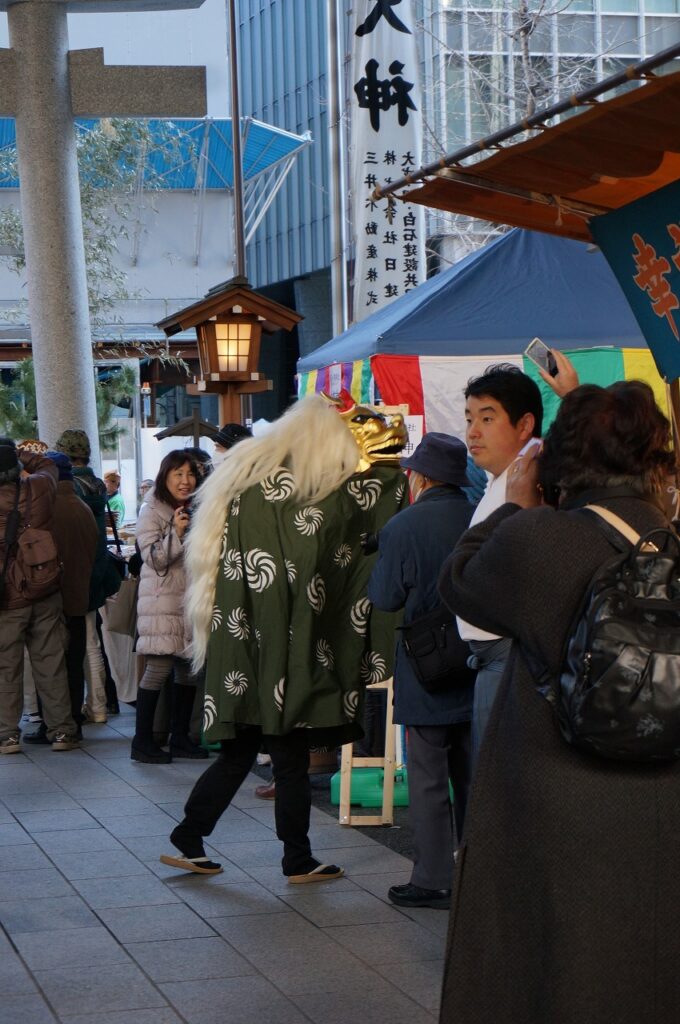

First up was the lion dance. A New Year’s tradition. The head of the lion is also gold, an auspicious look. There is a legend that if you ask a lion to bite your head, you will be happy, so if you meet one, be sure to offer your head. Next, the seven deities of good fortune continued to appear.


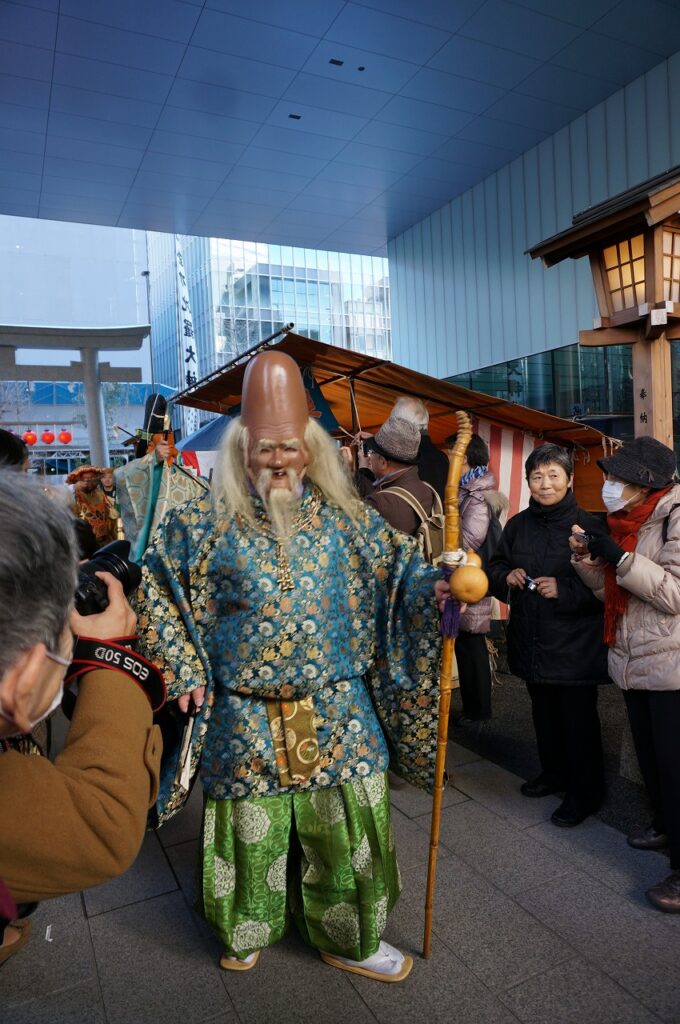
Hotei was originally a Chinese monk who was modeled after several real people. The image is that they carry a large sack, bare their large bellies, and travel in poor attire. He wears light clothes even in winter, but legend says that strangely enough, it never snowed around him. Jurojin and Fukurokuju are very similar because they were originally one deity that split into two. However, while Jurojin has the appearance of a noble old man in China, he is also characterized by an unusually long head.



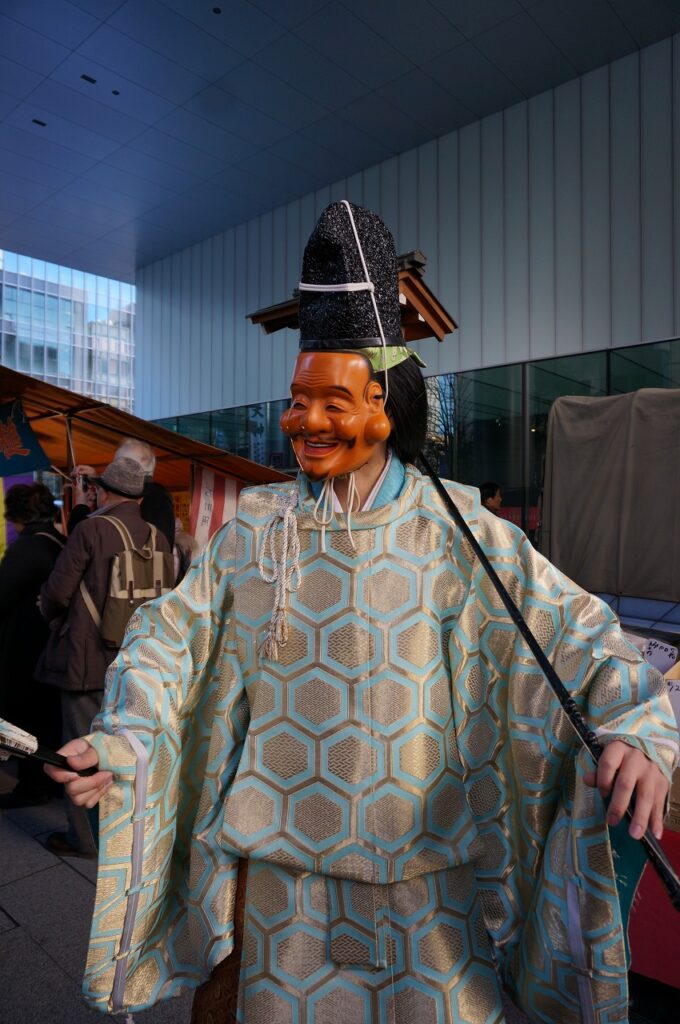


Ebisu and Daikoku have appeared many times on this site. Ebisu catches sea breams with his fishing rod, while Daikoku brings good fortune with the mallet he carries. Benzaiten is the only female deity. She is said to bestow arts and wealth.



Bishamonten is the god of war. Originally, he is one of the four guardian deities protecting the Buddha. However, his name changes to “Tamonten” at that time. Complicated? Don’t worry about it. Even Japanese people don’t know much about it. Behind them are the familiar entertainers, Hyottoko and Okame.

There is already a line of people ahead in front of the main shrine. It is like waiting for a star to appear.


At this situation, it seems almost like a red carpet, although there are no screams of excitement. The staff announced, “We have a little more time for photos. The star line-up doesn’t change every year. After this, they all gather in front of the stage and performed the Hyottoko and Okame dances. About 40 minutes. If you miss it here, don’t worry. The Seven Lucky Gods will appear again later.
You can enjoy the afternoon

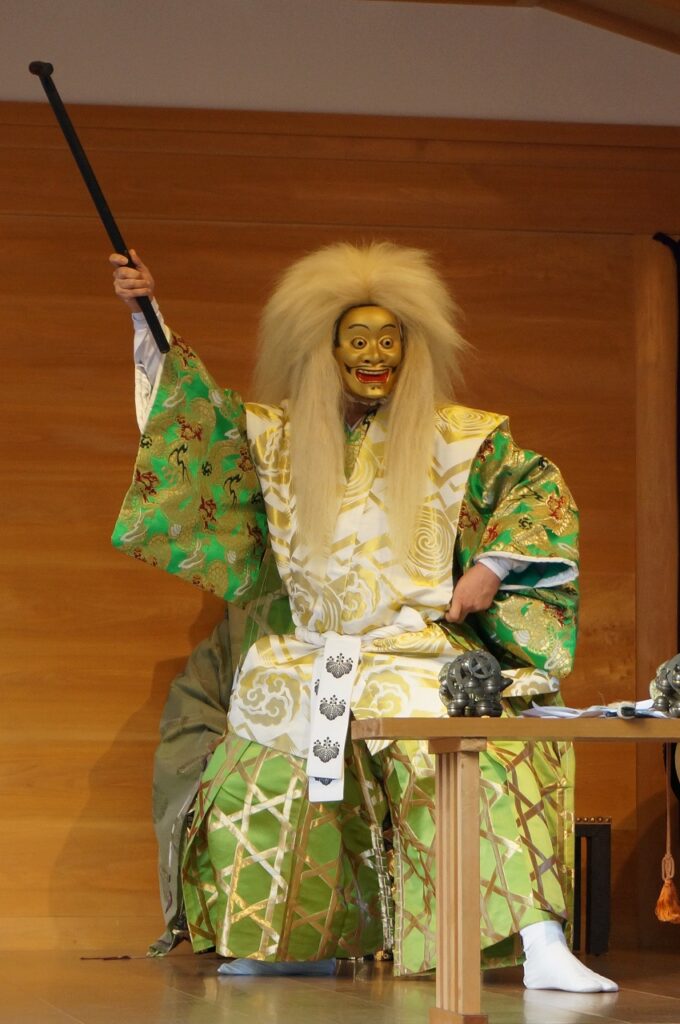
The content can also be enjoyed on video→https://youtu.be/q_8GYk038qA
At 1:30 in the afternoon, the event resumed again, starting with Kagura. This is the story of a sword smith. The emperor asks him to make a sword, and the master smith forges it every day. At the last moment, a god appears and breathes his soul into the sword.
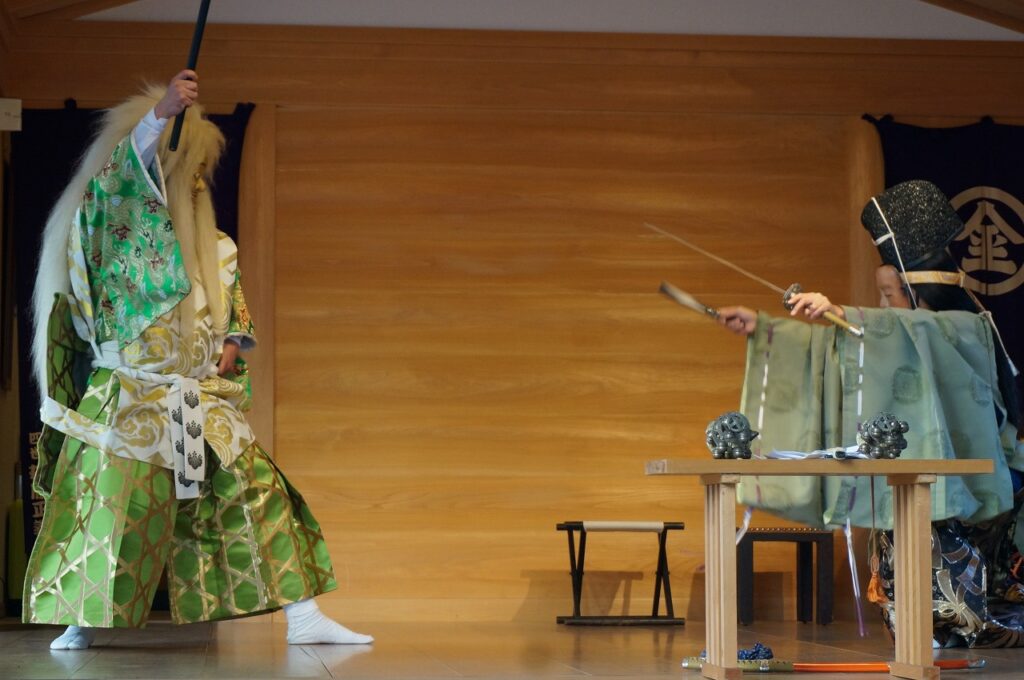

Now the enthusiasm again



The parade starts again at 2:00 p.m. Even though it’s the second time, it’s just as exciting as the first. There are as many people as the first time.


The second time, the flow is almost the same. A photo session in front of the main shrine (actually, the seven deities of good fortune don’t go in front of the main shrine for the photo session, they go to worship.) Then they all line up in front of the stage. And the Hyottoko and Okame perform a fun dance.


What is different from the first time is that folk dances and the stage performances of slightly different tricks are performed. This site is not the place to go into details of these unusual arts, but they are worth seeing at least once. Please come and enjoy it.
You should see this performance
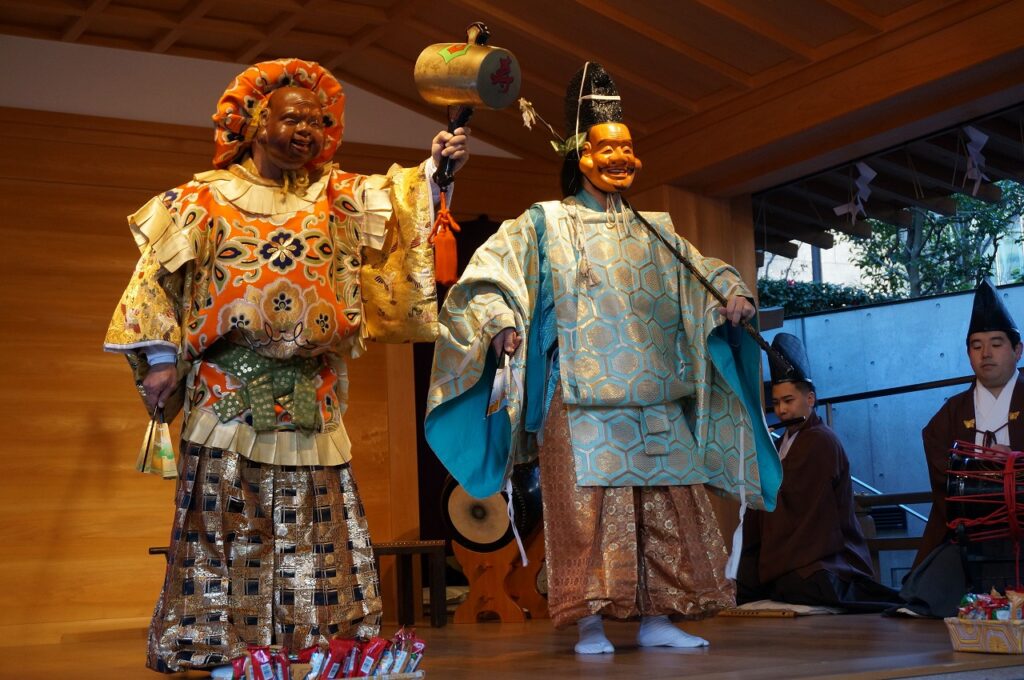

The content can also be enjoyed on video→https://youtu.be/egUg2D1wS0Q
Among the Seven deities of Good Fortune, the most popular duo is Ebisu and Daikoku. And they have a performance that every Japanese person knows. In the case of Ebisu, he uses his fishing line to catch a sea bream. The sea bream is a fish that symbolizes celebrations. While in the case of Daikoku, it is said that if he waves the mallet, good fortune will immediately appear. On the other hand, if Ebisu catches a sea bream, nothing will happen. Actually the sea bream is just a fake attached to the end of a hook. Nonetheless, when he catches a sea bream, people go into a frenzy. They fight to touch the snapper (even if it is fake).



And when Ebisu warms up the people enough, Daikoku comes out and literally brings good fortune out of his mallet. However, only cheap sweets are thrown. If you want to buy them, you can buy them at a nearby store. But people still fight to get their hands on these small blessings.
At the end
Until the 3rd, it is still in the festive New Year’s mood, and until the 7th, it is said to be within the period of celebrating New Year’s. As a way to mark the end of the year (although few people do this anymore), there is a custom of eating “nanakusa-gayu”(seven herb rice porridge) on the 7th. On New Year’s, TV personalities also wear kimonos. The number of people wearing kimonos increases in the town. It is also a time when the so-called “Japaneseness” of the country overflows. Not only the seven deities of good fortune, but also various other events are held. It might not be a bad idea to experience the Japanese New Year at least once.